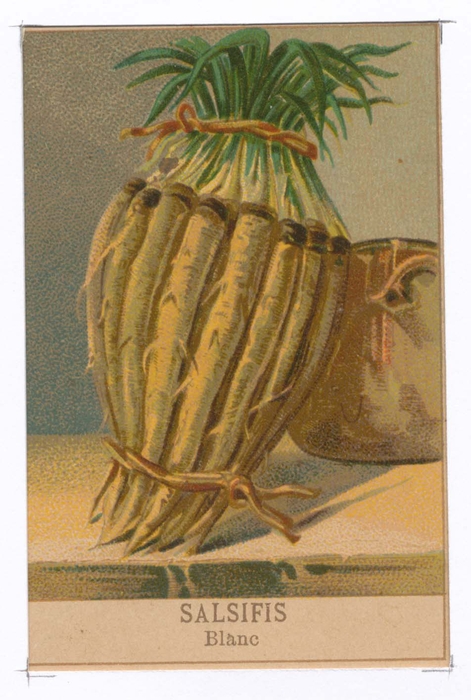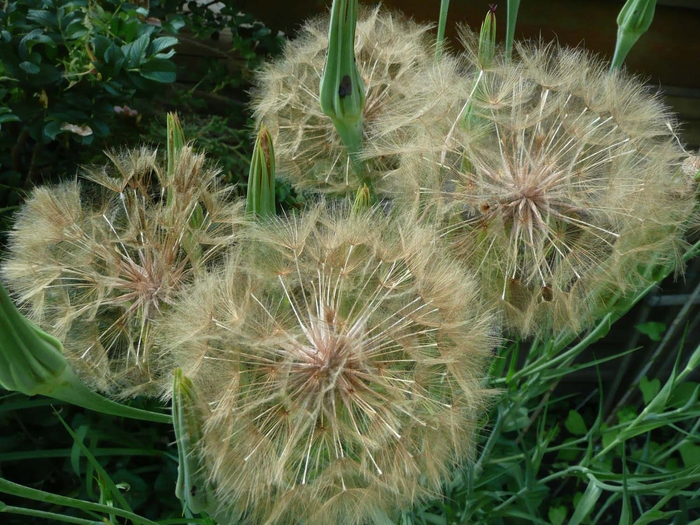Article body
I have got the seed of a vegetable resembling a parsnip, but in taste the bottom of an artichoke. The name is Salsifa, it is not in Lower Canada. The Indians brought it here first and now it is much cultivated in gardens. I got some yesterday as a present, it is excellent.
—Major Jasper Grant, writing in 1802 from Niagara Falls to his brother Thomas in Scotland[1]
Figure 1
Salsify Print
Myths around origins are easily invented. Jasper Grant was apparently unaware that the root vegetable salsify (pronounced salsifee) was being cultivated in his own country, where Scottish cookery writers had been discussing it back in the eighteenth century. According to Pennsylvania food historian and seed expert William Woys Weaver,[2] salsify was grown in his state by the Pennsylvania Dutch in the 1700s, but it was not a popular vegetable elsewhere in the United States until much later.
By the 1840s, if not sooner, Ontario farmers were being showered with instructions for growing and wintering salsify by the province’s agriculture journals and newspapers. Recipes for salsify cakes, soups, and salads, and for salsify as a vegetable fried, frittered, stewed, and boiled, were easily found in magazines and cookbooks up to the 1940s when the vegetable gradually slipped from view. A probable explanation is that salsify defies successful commercial marketing. The white roots theoretically stretch straight down in the soil for 10 to 15 inches, but they are inclined to finger and are easily bruised, causing discolouration. Like apples, once peeled and cut, the usual advice is to drop them in water with a bit of acid, such as lemon juice or vinegar.
Figure 2
Historically, salsify (Tragopogon porrifolius) was also known as oyster plant because of its supposed oyster taste. Older recipes often recommend adding a little codfish to stewed or boiled sliced salsify to increase the oyster flavour. It was also said to taste like asparagus, and the new shoots springing up from the base of the plant were harvested as pseudo-asparagus.
The cultivation of salsify is much the same as for carrots or parsnips, but salsify is biennial. Seeds planted in the spring produce roots that can be harvested in the fall, and, if kept over in the ground until the following spring, send up plants three feet high with pale-mauve flowers. The flowers quickly develop into large round seed pods by early July, continuing through August. In the old days the roots that were not harvested in October often were overwintered in the ground, covered with straw for later consumption, or were packed in fresh earth in the root cellar.
Figure 3
Figure 4
Figure 5
Today, Mammoth Sandwich Island seeds, the variety that was sold a hundred years ago, are listed by several Ontario seed companies. Be alert: there has long been confusion between salsify and scorzonera roots, the latter bearing yellow rather than mauve flowers, and with black roots, rather than white. “The so-called Black Oyster Plant is not a Salsify at all, but a Scorzonera, which although its root resembles the former, belongs to another genus.”[3]
Recipes
In Canada’s earliest cookbook, The Frugal Housewife’s Manual by A. B. of Grimsby, Ontario, the anonymous author writes of salsify as
a vegetable highly esteemed by those best acquainted with it ... there are various modes of dressing and cooking it ... it is excellent boiled and mashed up like squash and turnip, with a little salt and butter ... Some make soup of it; in that case it should be boiled and mashed fine in order to increase the flavour of the soup; a few pieces of salt codfish added, gives it a good relish. Others prefer it parboiled, and then sliced up and fried in batter, or without.[4]
B. goes on:
“If your gardeners would introduce it into market, and our citizens once try it, there would be no danger of its ever failing hereafter to be raised. It is in eating from November to May, precisely the period in which our vegetable market is most deficient in variety.”[5]
Salsify or Oyster Plant[6]
They are prepared for the table by slightly scraping the roots then they are cut in thin slices, and boiled in a very little water, seasoned with salt, until tender. When thus cooked, cream is poured in, with a little cod-fish, picked fine, and the whole allowed to boil up, when it is ready to be dished for the table. The cod-fish, if used very moderately, greatly increases the oyster-like flavour, for which this vegetable is so much esteemed.
Stewed Salsify[7]
-
1 bunch of salsify
-
1 cup milk
-
1 tablespoonful butter
-
3 tablespoonsfuls cracker crumbs
-
pepper and salt
Scrape a bunch of salsify and drop into cold water as you cut into inch lengths. Boil in hot, salted water until tender. Drain and pour into the saucepan with the salsify a cupful of hot milk. Simmer five minutes, and stir in cracker-dust, with pepper and salt. Stew gently for three minutes.
Salsify Salad[8]
-
1 cup of boiled salsify diced
-
1 cup of celery diced
-
1 cup of French dressing
-
6 stuffed olives
-
lettuce
Scrub and steam or boil salsify, then scrape and dice. Marinate the salsify and celery in French dressing for half an hour. Pile lightly on the lettuce, garnish with sliced olives.
[French Dressing is made up of salad [vegetable] oil, small quantities of scraped onion, dry mustard, paprika, sugar, salt and pepper, and either a flavoured vinegar or lemon juice.]
Salsify or Vegetable Oyster[9] ... may be boiled or fried and in soups or stews gives a delicate oyster flavour. This improved variety grows large and uniform and is pure white in color.
Appendices
Biographical note
Mary F. Williamson is a culinary historian whose research and publications focus primarily on food, cookery and cookbooks from the nineteenth to the mid-20th century. Mary is a longtime enthusiastic collector of historical cookbooks. She is retired from York University as Fine Arts Bibliographer and Adjunct Faculty member in Graduate Art History.
Notes
-
[1]
Jasper Grant fonds. Library and Archives Canada. R7960-0-1-E. Jasper Grant writing to Thomas Grant from Niagara, Upper Canada, on September 31, 1802.
-
[2]
William Woys Weaver, Heirloom Vegetable Gardening. New York: Henry Holt, 1997. p. 368.
-
[3]
Chas. E. Parnell, “Salsify,” reprinted from American Garden in The Canadian Horticulturist 6/4 (April 1883) p. 93.
-
[4]
A. B., The Frugal Housewife’s Manual (Toronto: J. H. Lawrence, 1840), 59.
-
[5]
Ibid., 59.
-
[6]
D. W. Beadle, Canadian Fruit, Flower and Kitchen Gardener (Toronto: J. Campbell, 1872), 252.
-
[7]
Grace E. Denison, The Canadian Family Cook Book (Toronto: McLeod and Allen, 1914), 167.
-
[8]
Elliot, Edith L., Salads That Are Different (Ottawa: Department of Agriculture, 1940), 6.
-
[9]
Dominion Seed House, Seed and Nursery Book for 1933 (Georgetown, Ontario: Dominion Seed House, 1943), 31.
Appendices
Note biographique
Mary F. Williamson est une historienne culinaire dont les recherches et publications portent sur la nourriture, la cuisine et les livres culinaires du 19ème au milieu du 20ème siècle. Mary est une collectionneuse passionnée de livres de cuisine historiques. Elle est retraitée de l’Université de York, où elle était bibliographe des beaux-arts et professeure auxiliaire en histoire de l’art.
List of figures
Figure 1
Salsify Print
Figure 2
Figure 3
Figure 4
Figure 5







